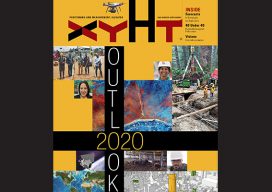Category Archives: Spatial IT/GIS

Technology to Buy Into: Riding High on AI
Artificial intelligence is making huge waves in the geospatial industry, changing how location information and BIMs are created from big data. Meet three startups at the forefront. (Image above: By applying computer vision to street imagery, Mapillary detects map data at scale.) Startups in the AEC realm have skyrocketed over the last decade. The availability...

Hidden Infrastructure in 3D: Visualizing with AR
A visualization platform overlays data displays on your view of a job site by fusing data, AR software, and mobile-device sensors. From Superman’s x-ray vision, to current technologies that use radio waves to sense objects through walls. The ability, fictional or actual, to “see” through obstacles has long been a source of fascination. (Above: An...

Outlook 2020’s 40 Under 40
The following is xyHt’s 2020 collection of 40 under 40: profiles of motivated and accomplished young professionals under 40 years of age. Click on each name to view their profiles below. Kwabena Obeng Asiam Researcher & Lecturer – Leibniz University Published PhD candidate in land administration; FIG Young Surveyors Ghana Evaluating the evidence and making...

Mentoring’s Evolution in GIS
Having focused on the education side of geography and geospatial technology for much of my career, I’m focusing this discussion on mentoring in formal and informal settings: schools, after-school clubs, libraries, museums, community and technical colleges, universities, and adult learning venues. As geotechnologies’ needs, audiences, and expectations have evolved, mentoring has evolved, and (I would...

Container 42: So Smart it Knows All the Answers
Container 42 and digital twins: the answer to life, the universe and how the Port of Rotterdam is transforming infrastructure management and operations. Editor’s Note: If you think the term “digital twin” is yet another high concept being foisted on surveyors and geospatial professionals in AEC, then you are not alone. But you are hearing...

Hydraulics in the Cloud
The City of Durham prepares for growth by collecting and leveraging data through a web-based GIS—to create a hydraulic model for its wastewater collection system. Durham, North Carolina is experiencing a growth rate it has never before known, with more people moving in, per capita, than all but three other cities in the country. Durham’s...
